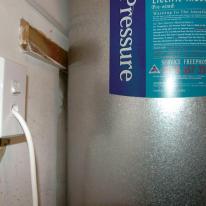Electric hot water cylinders – no hot water
Listed under: electrical, water heating, hot water cylinders, health and safety, electrical safety, Services
Cause
No power
Repair
- check to see if adjacent properties have also lost power; if so, the problem is with the mains supply
- check the main fuse or circuit breaker to see if it has tripped, that is, it is in the OFF position; if not, the problem is with the main supply
- if the main fuse has not blown or circuit breaker has not tripped and adjacent properties do have power, the problem is between the power transmission lines and the main switch board; contact the power supply company
- if the main fuse has blown or circuit breaker has tripped, the problem is in the house. Do not reset the circuit breaker or replace the fuse at this stage:
- check all appliances in the house and turn off as many as possible
- if the board has circuit breakers, switch them all off; reset the main circuit breaker to ON; turn branch circuit breakers on one at a time; if one fails to reset or trips the main circuit breaker, the problem is in that circuit breaker; contact a registered electrician to identify and repair the fault
- if the board has fuses, remove all branch fuses; replace the main fuse; replace branch fuses on one at a time until one blows again, indicating that the problem is in that circuit; contact a registered electrician to repair the fault
Cause
Faulty thermostat
Repair
-
confirm that power is being supplied to the water cylinder. Check that there is power coming into the house and that the relevant circuit breaker at the distribution board is on. If there are fuses, check that the fuse is not blown
-
check with your electricity provider whether you are setup on ripple control. Ripple control is where your provider can disconnect your hot water cylinder from the grid during peak times
-
check that the thermostat is at the right setting. Stored hot water should reach no less than 60°C to avoid the growth of Legionella bacteria. However, the delivery temperature of hot water to sanitary fixtures used for personal hygiene in housing such as baths, showers and hand basins must be no more than 50°C. (This was reduced from 55°C when G12/AS1 was amended in November 2023, with a 12-month transition period.)
-
if the thermostat is faulty it should be replaced
-
homeowners are permitted to remove and replace a water heater thermostat so long as it does not involve work on a switchboard. (The details are in the Electricity Act 1992 sections 79 and 80, and NZECP 51:2004 New Zealand Electrical Code of Practice for Homeowner/Occupier’s Electrical Wiring Work in Domestic Installations.) Landlords/ business owners cannot carry out electrical work in their rental properties or workplaces unless they hold the relevant licence
-
homeowners should only make this repair themselves if they have the skills, experience and tools to be able to safely and competently complete the job. You are required by law to carry out the work “in a workmanlike manner” and in compliance with all the relevant laws and codes
-
most homeowners should call a licensed plumber
Cause
Failed heating element
Repair
-
confirm that power is being supplied to the water cylinder. Check that there is power coming into the house and that the relevant circuit breaker at the distribution board is on or, if there are fuses, that the fuse is not blown
-
homeowners are permitted to remove and replace water heater elements so long as it does not involve work on a switchboard. (The details are in the Electricity Act 1992 sections 79 and 80, and NZECP 51:2004 New Zealand Electrical Code of Practice for Homeowner/Occupier’s Electrical Wiring Work in Domestic Installations.) Landlords/ business owners cannot carry out electrical work in their rental properties or workplaces unless they hold the relevant licence
-
homeowners should only make this repair themselves if they have the skills, experience and tools to be able to safely and competently complete the job. You are required by law to carry out the work “in a workmanlike manner” and in compliance with all the relevant laws and codes
-
most homeowners should call a licensed plumber
-
turn the power off and water heater off. Drain the cylinder then remove the heating element and replace. Ensure you replace the old element with a new one of equal wattage. If the original element was 2kW, then the replacement element should also be 2kW and no higher\
-
with very old cylinders, be aware that changes in pressure in the cylinder that come about from switching off, draining, refilling and switching on a tank again may potentially lead to stresses and leaks, for example in a welded seam. Carefully consider repair vs replacement. Replacement with a new cylinder must be carried out by a licensed plumber
-
you can find useful information about water heating systems on the government’s Gen Less website
Cause
Crossed hot and cold connections due to faulty plumbing installation
Repair
- although extremely unlikely, this is physically possible in a new house or where plumbing work has been carried out on an older house. To check for a crossed connection, close the hot water shut-off valve and then turn on a hot water tap. If there is continuous water flow, there is a crossed connection in the system
- call a licensed plumber to fix the plumbing system. Under the law this is not work that can be done on a DIY basis
- if the plumbing was installed relatively recently, call back the original plumber. There should obviously be no charge for the repair





